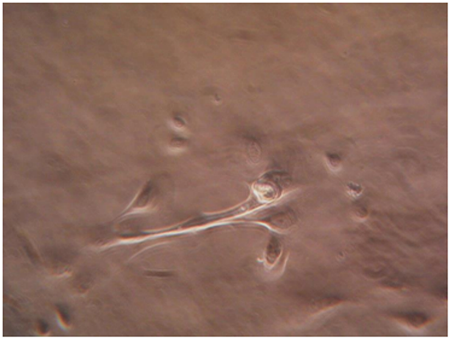
Comparative analysis of proliferative activity of oral and epidermal keratinocytes under the influence of epidermal growth factor
Abstract
Introduction and aim: Keratinocytes are the main cells of the stratified-squamous epithelium that covers oral cavity and skin. Keratinocytes of the oral cavity are, unlike epidermal, under the constant influence of EGF from saliva which increases their mitotic index and accelerates wound healing. The purpose of our research was to compare the proliferation rate of these two types of cells in “in vitro†conditions with identical cultivation media supplemented with EGF.
Material and methods: Biopsy material from three samples of both, oral mucosa and of the foreskin, were mechanically and enzymatically treated for primary isolation of keratinocytes. Identical number of cells of both the samples is cultivated in the culture vessels while adding nutrient medium supplemented with EGF. After 96 hours, the total number of keratinocytes was assessed in order to quantify the influence of EGF.
Results: Primary isolation of epidermal cells provided 2.5 times higher yield than the oral epithelium, but viability of keratinocytes was lower by approximately 25%. Very low and high concentrations of EGF have weak mitotic effect on the cells, whereas 5ng/L of this hormone gave the highest yield of both oral and epidermal keratinocytes. Yield of oral keratinocytes was by around 16% higher. Absence of this growth factor leads to a more rapid aging and growth arrest of the cultivated cells.
Conclusion: EGF is necessary for proliferation and differentiation of the keratinocytes. Oral keratinocytes have a higher proliferative capacity than epidermal ones while cultivated under the same conditions.Â
Full Text:
PDFReferences
Begnaud S, Chen T, Delacour D, Mège RM, Ladoux B. Mechanics of epithelial tissues during gap closure. Curr Opin Cell Biol 2016;42: 52-62
Brand HS, Ligtenberg AJ, Veerman EC. Saliva and wound healing. Monogr Oral Sci 2014; 24: 52-60.
Seeger MA, Paller AS. The Roles of Growth Factors in Keratinocyte Migration. Adv Wound Care (New Rochelle) 2015;4(4): 213-224
Nojiri T, Yoshizato T, Fukami T, Obama H, Yagi H, Yotsumoto F, Miyamoto S. Clinical significance of amphiregulin and epidermal growth factor in colostrum. Arch Gynecol Obstet 2012; 286(3): 643-647
Tuomela T, Viinikka L, Perheentupa J. Effects of estradiol and progesterone on epidermal growth factor concentration in plasma, bile, urine, submandibular gland and kidney of the mouse. Horm Res 1989; 31(3): 143-147.
Pastore S, Lulli D, Girolomoni G. Epidermal growth factor receptor signalling in keratinocyte biology: implications for skin toxicity of tyrosine kinase inhibitors. Arch Toxicol 2014; 88(6): 1189-1203.
Dotto P. The keratinocyte growth-differentiation switch. Front Biosci 1998;3:502-508
Gusak VK, Vasil'ev RG, Zubov DA, Slipchenko IO, Korchak OM, Popandopulo AG. Role of polypeptide growth factors in the regulation of epidermal keratinocyte proliferation. Tsitol Genet 2001;35(6): 64-73
Dickhuth J, Koerdt S, Kriegebaum U, Linz C, Müller-Richter UD, Ristow O, Kübler AC, Reuther T.In vitro study on proliferation kinetics of oral mucosal keratinocytes. Oral Surg Oral Med Oral Pathol Oral Radiol 2015;120(4): 429-435
Glaum R, Wiedmann-Al-Ahmad M, Huebner U, Schmelzeisen R. Tissue engineering of composite grafts: Cocultivation of human oral keratinocytes and human osteoblast-like cells on laminin-coated polycarbonate membranes and equine collagen membranes under different culture conditions. J Biomed Mater Res A 2010;93(2): 704-715
Zhou H, Zhou Z, Shang Q. Serial cultivation of normal human oral keratinocytes. Zhonghua Kou Qiang Yi Xue Za Zhi 2000;35(6): 455-457
Pellegrini G, Bondanza S, Guerra L, De Luca M. Cultivation of human keratinocyte stem cells: current and future clinical applications. Med Biol Eng Comput 1998;36(6): 778-790.
Castro-Muñozledo F, Hernández-Quintero M, Marsch-Moreno M, Kuri-Harcuch W. Cultivation, serial transfer, and differentiation of epidermal keratinocytes in serum-free medium. Biochem Biophys Res Commun 1997; 236(1): 167-172.
Xiao S, Zhu S, Ma B, Xia ZF, Yang J, Wang G A new system for cultivation of human keratinocytes on acellular dermal matrix substitute with the use of human fibroblast feeder layer. Cells Tissues Organs 2008;187(2): 123-130.
Shi L, Lei ZJ, Zhao CY, Lv XX, Jiang L, Li J, Li XY. A modified culture strategy of human keratinocytes to shorten the primary culture time. Cell Biol Int 2015; 39(9):1073-1079.
Grossman N, Slovik Y, Bodner L. Effect of donor age on cultivation of human oral mucosal keratinocytes. Arch Gerontol Geriatr 2004;38(2):114-122.
Ye D, Peramo A. Protocol for serial cultivation of epithelial cells without enzymes or chemical compounds. Methods Mol Biol 2014; 1195:23-32
Zare S, Zarei MA, Ghadimi T, Fathi F, Jalili A, Hakhamaneshi MS. Isolation, cultivation and transfection of human keratinocytes. Cell Biol Int 2014;38(4):444-451.
Rasmussen C, Thomas-Virnig C, Allen-Hoffmann BL. Classical human epidermal keratinocyte cell culture. Methods Mol Biol 2013; 945:161-175.
Turabelidze A, Guo S, Chung AY, Chen L, Dai Y, Marucha PT, DiPietro LA. Intrinsic differences between oral and skin keratinocytes. PLoS One 2014;9 (9): e101480.
Gibbs S, Silva Pinto AN, Murli S, Huber M, Hohl D, Ponec M. Epidermal growth factor and keratinocyte growth factor differentially regulate epidermal migration, growth, and differentiation. Wound Repair Regen 2000;8(3):192-203.
Seeger MA, Paller AS. The Roles of Growth Factors in Keratinocyte Migration. Adv Wound Care (New Rochelle) 2015;4(4):213-224.
Refbacks
- There are currently no refbacks.
